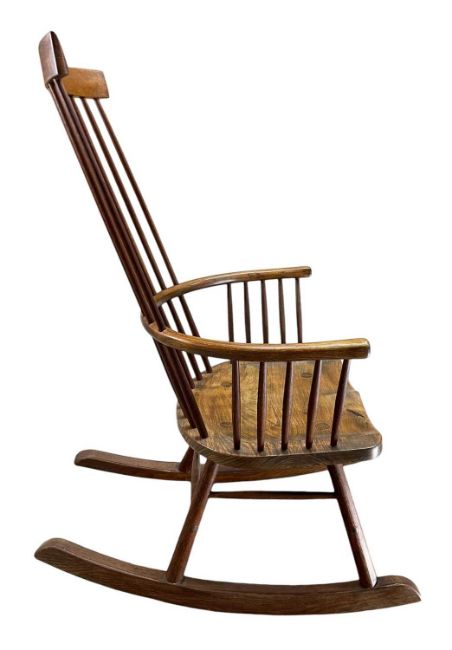
Earlier this month a John Brown chair surfaced at auction that was a highly unusual form: a comb-back rocking chair.
Commissioned in 1988, the chair was made for a family with a newborn and served as a nursing chair. From the seat up to the comb, the chair resembles JB’s cardigan chair, the chair he built for his book “Welsh Stick Chairs.” (FYI, many people don’t consider the cardigan chair to be a Welsh form, but that’s not part of this tale.)
Below the seat, things become unusual. Instead of an H-stretcher, the chair has a box stretcher and beefy rockers. The seat of the chair is elm, and it looks like the remainder of the chair is oak, though I can’t tell what species the rockers are.

The chair sold for the remarkable price of 550 GBP, according to Chris Williams, who tipped me off to the chair and the auction. Chris is the author of the excellent book “Good Work: The Chairmaking Life of John Brown.”
JB built the chair before Chris worked with him, so Chris was shocked to see the chair. “Can’t quite believe my eyes!!!” he wrote.
I’ve seen only one other stick chair that was a rocker, and it looked like that chair had the rockers added later.
— Christopher Schwarz


I didn’t realize that rockers were rarely stick chairs! Seems like a fun project to me…
That was a steal
I was wondering if the sale price was remarkable because it was low, or high. But it seems extremely low for a JB chair.
Very interesting. Always wondered if there was one out there, and from JB… cool. Hard to see on the pics but the legs look square to round?
I’ve modified two stick chair designs into rockers, straight forward and very effective!
1988 is an interesting date for reflection for that chair and others like it, for a couple of reasons.
First, in October 1987 the Southern parts of UK was on the receiving end of an exceptionally severe storm.
https://en.wikipedia.org/wiki/Great_storm_of_1987
One of the results of this event was the destruction of thousands of trees of all ages and descriptions across the southern counties and north-western France. Following this came a glut of timber, much of it pulped, but a lot came to the market very cheaply. In fact, I still have a small stack of very broad Yew boards from this time that I bought very cheaply when it was green.
Secondly is the fact that the seat is a single piece of Elm. Up to this point joined seat boards on chairs were unusual. The fact is that Elm of this quality – plentiful to the point of a glut in 1988 – is very hard to find nowadays. The 1980s in the UK saw a gradual advance of what was termed ‘Dutch Elm Disease’, a fungal infection from boring insects that resulted in the death of Elms. A long-term hedgerow and field tree – probably introduced by the Romans or earlier – it is now virtually extinct. There was a time through to the late 1990s where traditional broad Elm boards were available, even burned for firewood, because of the mass of dead Elm trees.
What mature Elms standing after that blight are now are carefully preserved. What was commonly used for floor-boards and coffins is now a thing of the past.
Is this a historic milestone? Have rocking chairs now officially been found to be worthy and acceptable within the ethos of LAP? I’m slack-jawed in amazement, bowing and genuflecting in appreciation. The identity of whomever it was who first put rockers on a chair is lost history, but surely almost nobody has given more pleasure to more people for longer than that one, including even the first person who dared et an oyster.
Would anyone have any advice on a chair I have, and no longer want? It’s an Edwin Skull plectaneum 1863. I’m not sure if it’s trash or treasure.